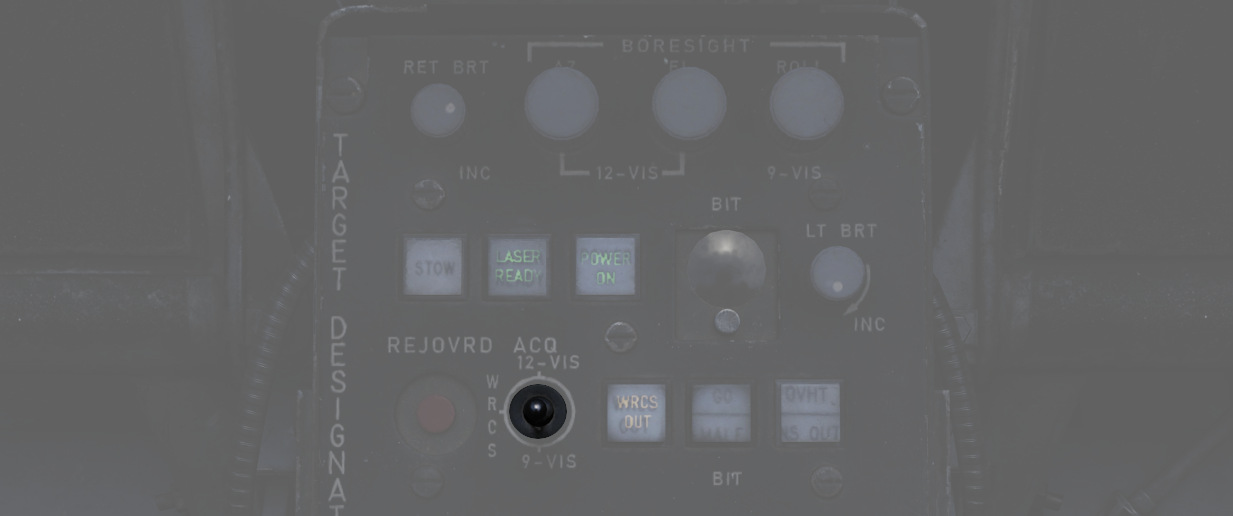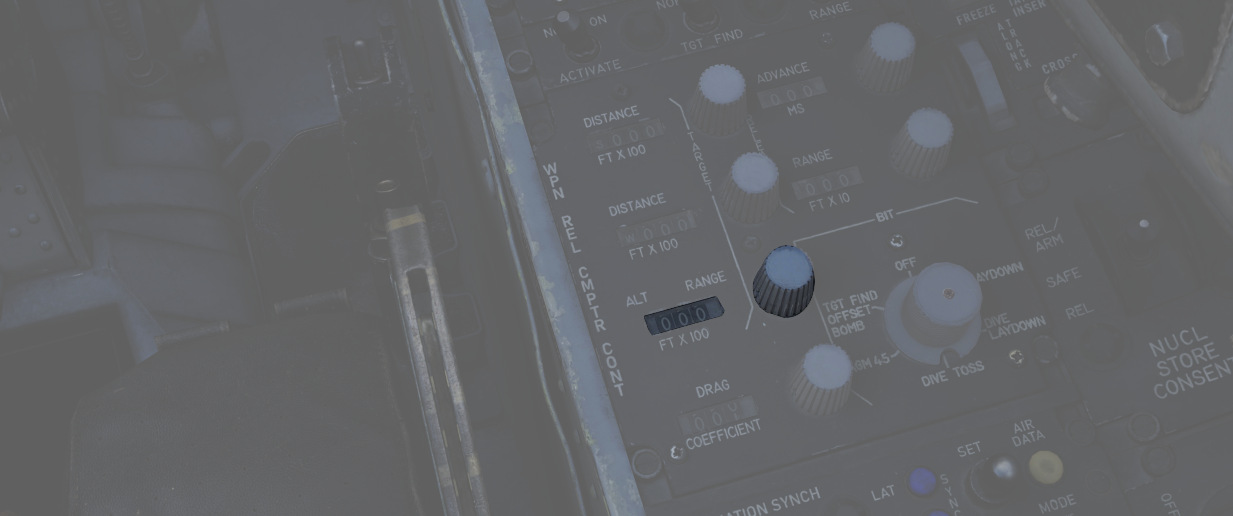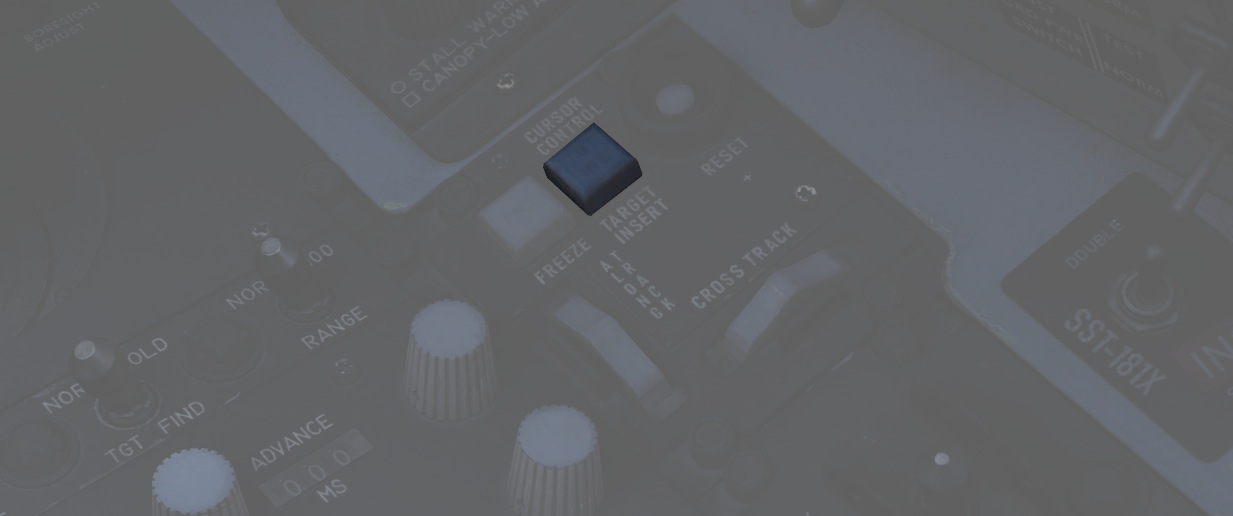Modes
Prior to being able to designate a target, one has to visually acquire the general target area and put the LOS in the vicinity. This is done by using one of three acquisition modes:
- 12-VIS
- 9-VIS
- WRCS
The modes can be selected by the WSO, using the Acquisition Mode Switch.

Visual modes
In 12-VIS and 9-VIS, the LOS is set to a fix position.
- 12-VIS: 0 degrees roll, -2 degrees elevation, looking slightly nose down
- 9-VIS: -90 degrees roll (CW), -90 degrees elevation (down), looking left
12-VIS can be a great way to find targets of opportunity, as it allows the pilot to put a target directly on the nose. The position also corresponds to the caged HUD reticle. Additionally, if the INS is integrated with the pod, 12-VIS is roll-stabilized.
The use of 9-VIS is very limited. It is intended to aid in acquiring a target while observing an area in a turn. The target has to be put on the extension of the left wing. However, in practice it is very difficult to maintain a turn in such an attitude.
WRCS mode
The main mode to acquire targets is the WRCS mode, in which the LOS is set to the current WRCS target. This usually corresponds to the cursor on the radar screen, but can also be set manually by the WSO. This enables the crew to spot a target, or general target area, by using the radar or entering known coordinates and then slewing the pod to this destination. If no specific target has been inserted, the WRCS usually defaults to the aircraft position, resulting in the pod looking straight down.
💡 The WRCS mode automatically falls back to the 12-VIS mode in case the WRCS integration is deactivated.
Track mode
Once the target, or general target area, has been found using the acquisition modes, the WSO can enter Track-mode by pressing the trigger on the Antenna Hand Control to either Half or Full Action.
💡 It is necessary for the trigger to go through the full sequence of for example Released to Half Action and back to Half Action in order to enter Track-mode.
In this mode, the Antenna Stick can be moved to slew the pod LOS. Operating the laser is only available in this mode, and can be activated by pressing the trigger on the Antenna Stick to Full Action.
Track mode is indicated by the T0 and TTG cues becoming visible on the display. They also indicate the status during laser operation.
If the INS is integrated with the pod, the image will automatically be space stabilized on the computed target position. Be aware that the stabilization is rudimentary and needs constant correction with the stick for the target to be kept centered.
The stabilization is mostly based on the measured slant range. Accurate slant range can be obtained by firing the laser. Alternatively, it is computed based on the aircraft barometric altitude and the target altitude, which can be set by the WSO on the WRCS panel.

Without a WRCS integration, a target altitude of 0 is assumed, degrading the stabilization.
💡 The pod is not capable of computing a slant range for targets above the own aircraft altitude (for example when attacking up-hill). Since that is measured using the barometric altitude, depending on the pressure-setting, this can lead to erratic behavior during hot days when flying low. Problematic situations like this were commonly referred to as Idiot mode, as the tracking system started to behave very odd and it was very difficult to restore proper behavior. The crew often had to deactivate the INS integration temporarily in order to disable the automatic tracking.
Memory Mode
Whenever a target-insert signal is send, the system activates the Memory-mode, provided it is currently in Track-mode and the WRCS integration is active.
In this mode, the line of sight is slaved to the current WRCS target, even if it is outside of the pods gimbal limits and cannot be displayed currently. The mode acts very similar to the WRCS-Acquisition mode.
The memory mode has to be left explicitly again, by either pressing half or full action on the Antenna Stick.
Target Insert
A target-insert signal is usually initiated by the WSO pressing the target-insert button.

However, when the pod is currently in Track-mode and is maneuvered outside of its gimbal limits, it will automatically initiate a target-insert signal and send its current target position to the WRCS.
💡 If the laser is currently firing, it will automatically be stopped when hitting a limit.
This signal then also causes the pod to enter Memory-mode, in which case it will continue to follow the position now memorized by the WRCS.
Additionally, the signal will also be send if the pod is deselected, i.e.
- Video Select Button - Weapon, or
- WSO DSCG Mode - not TV (for example switching to Radar)